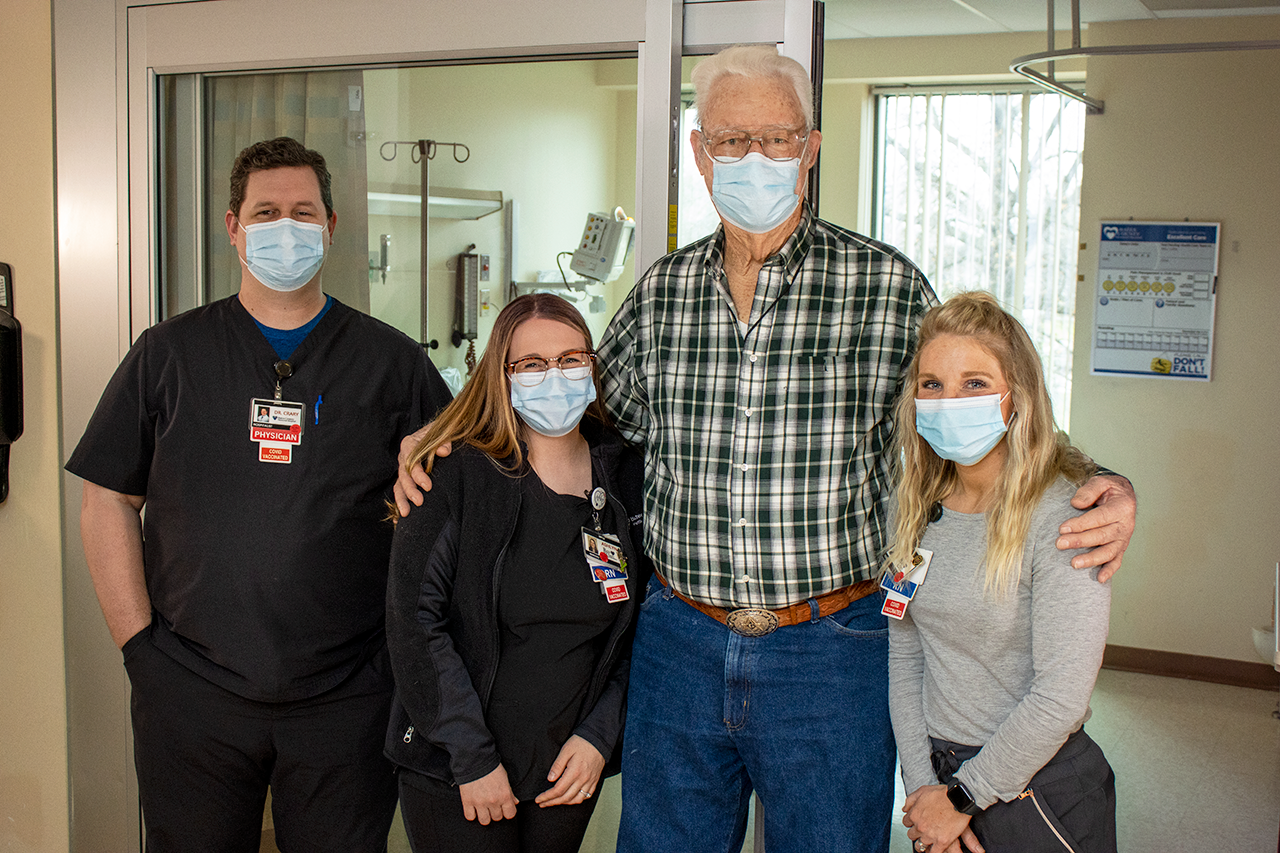Feeling Grateful to Whip COVID

Carl Stanfill said his first symptoms of COVID-19 were like a cold. On February 4, about a week into his illness, the 83-year-old Bates County resident said he experienced sudden, extreme weakness.
“I was down on the floor and couldn’t get up,” Carl said, recalling what prompted him to ask his wife Evelyn to call for an ambulance.
In the emergency room at Bates County Memorial Hospital, a team approach was taken to assess whether to care for Carl at BCMH or to find an open bed in a higher acuity hospital. Hospitals in the region were experiencing bed shortages at that time due to the surge of Omicron COVID, but after consulting Carl’s cardiologist, his doctors determined BCMH could provide the care he needed.
“I was ecstatic that I got to stay here. I did not want to go to the city,” Carl said. Aside from the comfort of being close to home, he knew being hospitalized in a distant location would be difficult for his wife and family.
Carl was gravely ill when he was admitted, and remained in the critical care unit (CCU) for the duration of his stay at BCMH. His care team included BCMH hospitalists (physicians dedicated to caring for hospitalized patients), critical care nurses and specialists through the hospital’s telemedicine program with St. Luke’s Health System. This special program allowed pulmonary specialists from a remote location to evaluate and speak to Carl in real time through a screen in his room, and form a plan of action with his doctors on site.
“The thing is, my mind was always active,” Carl said. “It didn’t affect my mind, it just tore my body all to pieces. I feel extremely fortunate to be able to whip this.”
Carl was hospitalized for seven days with COVID pneumonia and hypoxic respiratory failure (low oxygen). COVID also put a strain on his heart resulting in elevated cardiac enzymes. Carl’s treatment included steroids and Remdesivir, an antiviral medication approved by the FDA for treatment of covid pneumonia.
Dr. Benjamin Crary, a hospitalist at BCMH, was on call during the latter part of Carl’s stay. Carl was responding to treatment, but Dr. Crary saw a significant difference in his strength as a result of daily rehabilitation treatments with a physical therapist (PT).
“He was definitely weak from being in bed due to his illness, and working with a PT figuratively and literally got him back on his feet,” Dr. Crary said.
Scott Ridings, a physical therapist who treats inpatients at BCMH, said it’s important for his patients with a pulmonary issue like COVID-19 to keep oxygen saturation levels above 90%, the level where the body responds best in terms of function and activity level.
“My goal is to get them up and moving as early as they can, and to do whatever they can tolerate,” Scott said.
In Carl’s case, physical therapy started with short walks assisted by a walker and five liters of continuous flow oxygen. In three days, he was able to reduce to one to two liters. Carl’s quick response is not always the case, Scott said, and depends on each individual’s makeup including comorbidities.
“Some patients may only tolerate a few feet on day one, or just transfer from the bed to a chair. The key is mobility with appropriate levels of supplemental oxygen, so all systems improve for greater function and mobility.”
When Carl was discharged from the hospital, he continued at-home physical therapy services. Like many other patients who have been hospitalized for COVID, Carl’s recovery has been gradual. Now going on two months since he became ill, he still needs supplemental oxygen, but his spirits are high, and he is quick to point out his victories. After a recent visit with his family doctor, James Miller, D.O., Carl celebrated that he would be able to reduce his oxygen from three liters per nasal cannula to two.
When it comes to expressing his gratefulness for “whipping COVID”, Carl does not hold back from including his medical team.
“I would like people to know how good of a hospital they have here,” Carl said. “They just did a fantastic job. I can’t say enough good about them.”
